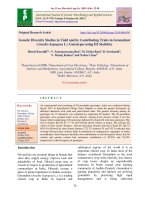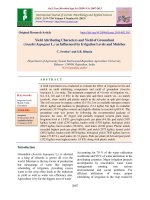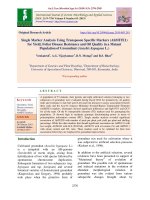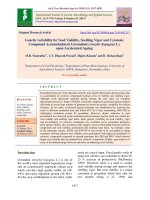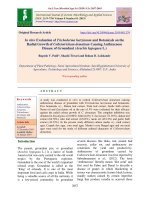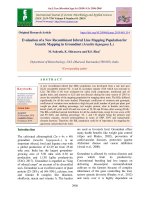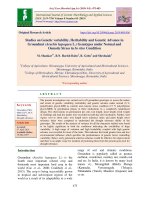Studies on genetic variability, heritability and genetic advance in groundnut (Arachis hypogaea L.) genotypes under normal and osmotic stress in in vitro condition
Bạn đang xem bản rút gọn của tài liệu. Xem và tải ngay bản đầy đủ của tài liệu tại đây (667.89 KB, 11 trang )
Int.J.Curr.Microbiol.App.Sci (2019) 8(5): 473-483
International Journal of Current Microbiology and Applied Sciences
ISSN: 2319-7706 Volume 8 Number 05 (2019)
Journal homepage:
Original Research Article
/>
Studies on Genetic variability, Heritability and Genetic Advance in
Groundnut (Arachis hypogaea L.) Genotypes under Normal and
Osmotic Stress in In vitro Condition
M. Shankar1*, B.N. Harish Babu2, R. Gobu1 and Sheshaiah1
1
College of Agriculture, Shivamogga, University of Agricultural and Horticultural Sciences,
Shivamogga, Karnataka, India
2
College of Horticulture, Hiriyur, Chitradurga (Dist), University of Agricultural and
Horticultural Sciences, Shivamogga, Karnataka, India
*Corresponding author
ABSTRACT
Keywords
Groundnut, PEG6000, GCV, PCV,
Heritability,
Drought tolerance
Article Info
Accepted:
07 April 2019
Available Online:
10 May 2019
The present investigation was carried out in 49 groundnut genotypes to assess the nature
and extent of genetic variability, heritability and genetic advance under normal (0 %
polyethylene glycol-6000 as control) and osmotic stress condition (15 % polyethylene
glycol-6000) in germination phases in three replications in a completely randomized
design. The observations on germination per cent, root length, shoot length, fresh weight
of seedlings and total dry matter were recorded on tenth day after incubation. Further, seed
vigour, root to shoot ratio, root length stress tolerance index and plant height stress
tolerance index were computed to understand the drought tolerance ability of the
genotypes. The results of the analysis of variance for all the characters studied were found
to be highly significant in both the conditions indicating the availability of huge
variability. A high range of variation and high heritability coupled with high genetic
advance was recorded for most of the traits. This indicates the broad genetic base and less
environmental influence which specifies the predominance of genetic factor controlling
variability. Hence, early generation selection schemes would be effective for improvement
and there is an ample scope for isolation of promising lines from the present gene pool for
drought tolerance.
range of soil and climatic conditions.
Groundnut is popularly called as peanut,
earthnut, wondernut, monkey nut, manila nut
and etc. In India, it is known by many local
names viz., Moongphali (Hindi), Shenga
(Kannada),
Verusenagalu
(Telugu),
Nilakadalai (Tamil), Mandavi (Gujarati) and
so on.
Introduction
Groundnut (Arachis hypogaea L.) is the
fourth most important oilseed crop and
thirteenth most important food crop in the
world (Cuc et al., 2008; Coulibaly et al.,
2013). The crop is being successfully grown
in tropical and sub-tropical regions of the
world as a result of its adaptability to a wide
473
Int.J.Curr.Microbiol.App.Sci (2019) 8(5): 473-483
Groundnut (2n=40) has emerged as an
economically important crop due to its
significant share in vegetable oil production
of India. Abiotic stress has been reported as a
major constrain for groundnut production and
recent abrupt climate change is making the
abiotic stresses more common in the country.
Water stress severely affects growth and
development at all growth stages of plant.
lines and cultivated varieties for drought
tolerance is the initial step in developing
cultivars with both high yield and drought
tolerance. However, drought tolerance
screening under field conditions needs lot of
resources like land, labor, rain-free
environment and planning of the experiment.
Further, it also depends on the environmental
influences that change phenotypic expression
of a genotype.
Agronomic interventions poses their own
importance in abiotic stress tolerance, since
genetic solutions are unlikely to close more
than 30 per cent of the gap between potential
and realized yield under water stress
(Edmeades et al., 2004). Though, enhanced
genetics can be easily packaged in a seed and
therefore more effortlessly and completely
adopted than improved agronomic practices
that depend more heavily on input
availability, infrastructure, and skills in crop
and soil management (Campos et al., 2004).
So, the use of genetics and plant breeding
aspects to improve drought tolerance and
provide yield stability is an important part of
the solution to stabilizing global groundnut
production.
The study of effect of drought stress by using
osmotic solutions in germinal stage is one of
the alternative methods for drought tolerance
screening. Plants tolerant to the abiotic
stresses can be obtained by applying the
selective agents such as NaCl, for salt
tolerance, mannitol or polyethylene glycol
(PEG), for drought tolerance (Errabii et al.,
2008).
Polyethylene glycol is a superior choice for
imposing low water potential as like similar to
drying soil than the frequently employed
solute mannitol, for the reason that mannitol
has been shown to be taken up by plant cells
and can cause specific toxic effects on growth
and development (Hohl and Schopfer, 1991;
Verslues et al., 1998).
However, the crop improvement for water
stress requires incessant efforts chiefly,
through the knowledge of genetic mechanism
governing heritable character. Genetic effects
of heritable character lead a plant breeder to
an obvious understanding of inheritance
patterns of various plant characters as their
relative contribution to the absolute yield.
Screening genotypes at seedling phase is
found to have several benefits, such as
screening large set of germplasm with more
accuracy, less effort, low cost, less laborious,
ease of handling and getting clear of
susceptible genotypes at an early stage. In
addition, seedling characters have also shown
moderate to high heritability with additive
type of genetic variance within and over
environments (Rauf et al., 2009).
Efficient improvement of any crop depends
chiefly on the information on genetic
variability and diversity which outlines the
basis for any crop breeding programme.
Further, the triumph of any crop improvement
programme depends on the amount of genetic
variability present in the population for the
character for which the improvement is
designed at. So, screening the germplasm
Several authors reported the use of
polyethylene glycol (PEG-6000) for in vitro
drought screening in crop plants (Gobu et al.,
2014). Moreover, seedling characters have
also revealed moderate to high heritability
474
Int.J.Curr.Microbiol.App.Sci (2019) 8(5): 473-483
with additive form of genetic variance over
and within environments (Rauf et al., 2009).
There are very little reports available on the
genetics of drought tolerance in groundnut.
Hence, in this study we made an attempt to
know the nature and extent of genetic
variability, heritability and genetic advance of
characters concerned in drought tolerance.
wet germination paper. Seeds were moistened
with distilled water for control petri-plates
and with 15 % PEG-6000 solution for
treatment petri-plates and were incubated for
10 days at room temperature. At periodic
interval, 1 ml of distilled water or PEG-6000
solution was added to petri-plates to manage
the germination paper adequately moist
during the period of incubation. Seed
germination was taken on day to day basis.
The observations on germination per cent,
seedling length, shoot length, root length,
fresh weight of seedlings and total dry matter
were noted on 10th day after incubation (Plate
1). Further, root to shoot ratio, seed vigour,
plant height stress tolerance index and root
length stress tolerance index, were estimated
to have a greater understanding on their
drought tolerance potentiality. Seed vigor was
determined using the following formula
(ISTA, 1985).
Materials and Methods
The research materials used in the study
consisted of 49 genotypes (Table 1). They
were screened under drought stress (induced
osmotic stress) and non-stress (normal)
conditions (Plate 1). Each of the 49 genotypes
was subjected to osmotic stress at germination
stage induced by Polyethylene Glycol-6000
(PEG-6000) at 15.0 % (equivalent to - 3 bars,
as described by Michel and Kaufmann, 1973)
in 3 replications in a completely randomized
design as reported by Shankar et al., (2016).
For control, sterile distilled water was used
instead of PEG-6000 for seed germination
and seedling growth.
Seed vigour = Germination percentage ×
Seedling length (cm).
Root length stress tolerance index (RLSI) and
plant height stress tolerance index (PLSI)
were calculated as given by Ashraf et al.,
(2006) using the consecutive formula:
Ten seeds per genotype per replication were
surface sterilized with 70 per cent ethanol for
1 minute. Later, the seeds were rinsed
thoroughly with distilled water for three times
and seeds were put up in petri-plates having
Root length of stressed seedlings (cm)
Root length stress tolerance index =
Root length of control seedlings (cm)
Plant height of stressed seedlings (cm)
Plant height stress tolerance index =
Plant height of control seedlings (cm)
The statistical analysis of the data on the
individual characters was carried out on the
mean values of ten random plants and
analyzed by using Windostat software
package (Version 9.2). The analysis of
variance for each character was analyzed by
adopting Completely Randomized Design as
suggested by Cochran and Cox (1957). The
mean, range and variance values of each
character were calculated for each genotype.
× 100
×100
The coefficient of variation both at
phenotypic and genotypic levels for all the
characters were computed by applying the
formula as suggested by Burton and Devane
(1953). PCV and GCV were classified into
low (0 – 10 %), moderate (11 – 20 %) and
high (21 % and above) as suggested by
Subramanian and Menon (1973). Heritability
in broad sense for all the characters was
computed by the formula suggested by
475
Int.J.Curr.Microbiol.App.Sci (2019) 8(5): 473-483
Hanson et al., (1956). Heritability was
classified into low (0 – 30 %), moderate (31 –
60 %) and high (61 % and above) as
suggested by Robinson et al., (1949). The
predicted genetic advance was estimated
according to the formula given by Johnson
and Robinson (1955). The genetic advance as
per cent of mean was categorized into low (0
– 10 %), moderate (10.1 – 20 %) and high (>
20.1 and above) as suggested by Johnson and
Robinson (1955).
overall mean of 78.70 per cent. On the other
hand, under normal condition (0 % PEG), the
mean germination per cent recorded was
99.32 with a range of 93.33 to 100 per cent.
Germination per cent in both control and
stress situation showed low phenotypic coefficient of variation (PCV) and genotypic
coefficients of variation (GCV) coupled with
a moderate heritability. This trait showed low
genetic advance over mean (GAM) in both
control and stress conditions. This result
clearly depicts that the germination
percentage can be used as selection criterion
in groundnut for drought tolerance. These
results are in agreement with that of Shankar
et al., (2016), Gobu et al., (2014), Saensee et
al., (2012), Contamutto et al., (2010), Ahmad
et al., (2009), Iqbal and Asraf (2006), Kaya et
al., (2006) and El-Midaoui (2003) as for as
the use of PEG-6000 for drought stress
tolerance in different crop plants.
Results and Discussion
Analysis of variance was done to test the
significance differences among genotypes
studied in both moisture stress (15 % PEG6000) and normal condition (0 % PEG-6000).
Analysis of variance revealed that, the
genotypes under study differed significantly
even at one per cent level of probability for
all characters studied in both moisture stress
and normal conditions. The mean sum of
squares of all the characters is presented in
Tables 2 and 3 for moisture stress and normal
(without
moisture
stress)
conditions,
respectively.
Root length
Comparison between phenotypic co-efficient
of variation and genotypic co-efficient of
variation for all the characters studied under
stress and normal condition is represented in
figure 1. Comparison between broad sense
heritability and genetic advance over mean
for all the characters studied in in vitro
screening under stress and normal condition is
represented in figure 2. The estimate of
various genetic parameters under osmotic
stress and normal condition is given in tables
3 and 4 respectively.
Under moisture stress condition (15 % PEG6000), the mean root length recorded was
5.83 cm with a range of 2.81 to 8.64 cm.
However, under normal condition, the root
length ranged from 1.31 to 6.72 cm with a
mean of 3.30cm. The phenotypic and
genotypic co-efficient of variability in both
stressed and control condition were high with
high heritability and high genetic advance
over mean. This clearly indicates that, there
exists a possibility of this trait being under the
influence of additive gene action which
provides a better scope for selection of
genotypes for drought tolerance based on
increased root length under moisture stress
environments.
Germination per cent
Shoot length
The mean germination percentage under
moisture stress induced by 15 % PEG-6000
was in the range of 70.00 to 82.00 with an
The mean shoot length under moisture stress
was 2.40 cm and ranged from 2.12 to 2.79
cm. But under normal condition, the mean
476
Int.J.Curr.Microbiol.App.Sci (2019) 8(5): 473-483
shoot length recorded was 5.75 cm with a
range of 3.81 to 9.60 cm. This character
showed low genotypic and phenotypic
coefficients of variability under moisture
stress condition. But, it exhibit high genotypic
and phenotypic coefficients of variability in
control condition. It possesses high
heritability under both moisture stress and
non-stress conditions. However, the genetic
advance over mean was moderate (under
stress condition) to high (under control)
indicating the possibility of selection for this
trait both under control and stress conditions.
Fresh weight of the seedlings
The minimum and maximum fresh weights of
the seedlings under moisture stress were 5.06
and 10.69 mg, respectively with a mean of
7.18 mg. The fresh weight of the seedlings
under normal condition ranged from 8.52 to
19.62 mg with a mean of 13.02 mg. The GCV
and PCV for fresh weight under both control
and stressed were moderate besides having
high heritability coupled with high genetic
advance over mean.
Dry weight of the seedlings
Root to shoot ratio
Under the moisture stress induced by 15 %
PEG-6000, the dry weight of the seedlings
ranged from 2.51 to 5.73mg with a mean of
3.83mg. In case of normal condition, the
mean dry weight of the seedlings was 3.98mg
and ranged from 2.95 to 6.58mg. However,
the dry weight of the seedlings in both
stressed and control condition showed
moderate
genotypic
and
phenotypic
coefficients of variability akin to fresh weight
of groundnut seedlings in the present
investigation. Further, it also showed similar
tendency to that of fresh weight of seedlings
in having high heritability along with high
genetic advance over mean.
The mean root to shoot ratio under moisture
stress was 2.43 and it was in the range of 1.20
to 3.68. Under normal condition, the root to
shoot ratio was in the range of 0.34 to 1.02
with a mean of 0.58. This trait exhibited
moderate
genotypic
and
phenotypic
coefficients of variation in stressed condition
whereas it has recorded high genotypic and
phenotypic coefficients of variation under
control condition. Further, this trait has shown
high heritability with high genetic advance
over mean and is known to play a pivotal role
in drought tolerance.
Seed vigour
Plant height stress tolerance index (PHSI)
and Root Length Stress Tolerance Index
(RLSI)
The seed vigour under moisture stress was in
the range of 383.41 to 900.35 with a mean of
648.92. However, under normal condition, the
mean seed vigour was 899.19. The lowest and
the highest seed vigour were recorded 512.02
and 1549.68, respectively.
The mean PHSI ranged between 25.43 and
59.83 with an overall mean of 43.57. The
RLSI observed was 196.38 and it ranged from
69.25 to 468.67.
Seed vigour exhibited moderate genotypic
and phenotypic coefficients of variation in
stressed condition in comparison to their
higher values under control condition. This
trait seems to be less influenced by
environmental factors as indicated by high
heritability and high genetic advance over
mean.
Root length stress tolerance index (RLSI)
showed high genotypic and phenotypic
coefficients of variability whereas plant
height stress tolerance index (PHSI) showed a
moderate values for these two genetic
parameters.
477
Int.J.Curr.Microbiol.App.Sci (2019) 8(5): 473-483
Table.1 List of groundnut genotypes used in the present investigation
Sl. No.
1
2
3
4
5
6
7
8
9
10
11
12
13
14
15
16
17
Where,
Genotypes
Dh-241
Dh-235
Dh-234
Dh-243
Dh-245
Dh-246
Dh-247
Dh-216
K-6
K-9
ICGV-91115
Dh-101
G2-52
GPBD-4
Dh-86
TMV-2
GPBD-5
UAS, Bangalore
UAS, Dharwad
UAS, Raichur
VB
SB
Pedigree
UAS,D
UAS,D
UAS,D
UAS,D
UAS,D
UAS,D
UAS,D
UAS,D
UAS,B
UAS,B
UAS,B
UAS,D
UAS,D
UAS,D
UAS,D
UAS,B
UAS,D
-
Sl. No.
18
19
20
21
22
23
24
25
26
27
28
29
30
31
32
33
34
Genotypes
UAS,D -1
R-2001-3
VB-T4
KCG-6
SB-T1
SB-T17
VB-T11
VB-T14
SB-T7
SB-T14
UAS,D -2
UAS,D -3
SB-T15
ICGV-91114
VB-T31
SB-T12
SB-T13
Pedigree
UAS,D
UAS,R
UAS,B
UAS,B
UAS,B
UAS,B
UAS,B
UAS,B
UAS,B
UAS,B
UAS,D
UAS,D
UAS,B
UAS,B
UAS,B
UAS,B
UAS,B
Sl. No.
35
36
37
38
39
40
41
42
43
44
45
46
47
48
49
University of Agricultural Sciences, Bangalore, Karnataka.
University of Agricultural Sciences, Dharwad, Karnataka.
University of Agricultural Sciences, Raichur, Karnataka.
Valencia Bunch
Spanish Bunch
478
Genotypes
KCG-2
VB-T13
VB
VB-T18
SB-T3
SB-T40
VB-T35
SB-T2
SB-T10
SB-T21
VB-T3
SB-T11
VB-T7
SB-T16
SB-T8
Pedigree
UAS,B
UAS,B
UAS,B
UAS,B
UAS,B
UAS,B
UAS,B
UAS,B
UAS,B
UAS,B
UAS,B
UAS,B
UAS,B
UAS,B
UAS,B
Int.J.Curr.Microbiol.App.Sci (2019) 8(5): 473-483
Table.2 Analysis of variance in groundnut genotypes under moisture stress induced by 15 %
PEG-6000 in in vitro experiment
Source
d.f.
Germinatio
n per cent
17.44**
Root
length
(cm)
4.76**
Shoot
length
(cm)
0.07**
Root to
shoot
ratio
0.74**
Genotypes
48
Error
S.Em
CV%
CD5%
CD1%
98
6.62
1.49
3.27
4.17
5.52
0.045
0.11
3.22
0.30
0.40
0.004
0.04
2.74
0.11
0.14
0.01
0.06
4.29
0.17
0.22
Seed
vigour
62735.91
**
1529.34
22.58
4.89
63.37
83.88
Fresh
weight
(mg)
3.16**
Dry
weight
(mg)
1.37**
RLSI
PHSI
18065.96**
220.26**
0.10
0.18
4.45
0.52
0.69
0.03
0.10
4.56
0.28
0.38
106.49
5.96
5.26
16.72
22.13
3.09
1.01
4.03
2.85
3.77
Table.3 Analysis of variance in groundnut genotypes under normal condition (0 % PEG-6000) in
in vitro experiment
Source
d.f.
Genoty
pes
Error
S.Em
CV%
CD5%
CD1%
48
98
Germinatio
n per cent
12.47**
Root length
(cm)
3.80**
Shoot
length (cm)
5.49**
Root to
shoot ratio
0.076**
3.40
1.07
1.86
2.99
3.96
0.01
0.06
3.13
0.17
0.22
0.02
0.09
2.71
0.25
0.33
0.001
0.015
4.64
0.04
0.06
Seed vigour
150942.76**
Fresh
weight (mg)
21.64**
Dry weight
(mg)
1.63**
685.36
15.12
2.91
42.42
56.16
0.29
0.31
4.11
0.87
1.15
0.03
0.10
4.05
0.26
0.35
Where,
** - Significance @ 1 %,
d.f. - Degrees of freedom
* - Significance @ 5%
RLSI – Root length stress tolerance index
PHSI – Plant height stress tolerance
index
Table.4 Estimates of genetic parameters in groundnut genotypes under moisture stress induced
by 15 % polyethylene glycol-6000 (PEG-6000) in in vitro experiment
Sl.No.
1
2
3
4
5
6
7
8
9
Where,
Character
Germination (%)
Root length (cm)
Shoot length (cm)
Root to shoot ratio
Seed vigour
Fresh weight (mg)
Dry weight (mg)
RLSI
PHSI
Mean
78.70
5.83
2.40
2.43
648.92
7.18
3.83
196.38
43.57
Range
70.00-82.00
2.81-8.64
2.12-2.79
1.20-3.68
383.41- 900.35
5.06-10.69
2.51-5.73
69.25 - 468.67
25.43 - 59.83
RLSI – Root length stress tolerance index
PCV – Phenotypic coefficient of variation
h2– Broad sense heritability
PCV (%)
4.60
21.75
6.84
20.78
17.49
14.74
18.02
39.75
19.94
GCV (%)
2.41
21.51
6.27
20.33
16.99
14.06
17.43
39.40
19.53
h2(%)
35.25
97.81
83.95
95.74
94.36
90.89
93.60
98.25
95.91
GAM (%)
2.95
43.82
11.83
40.98
33.99
27.60
34.74
80.45
39.40
PHSI – Plant height stress tolerance index
GCV – Genotypic coefficient of variation
GAM – Genetic advance as per cent over mean
479
Int.J.Curr.Microbiol.App.Sci (2019) 8(5): 473-483
Table.5 Estimates of genetic parameters in groundnut genotypes under normal condition (0 %
PEG-6000) in in vitro experiment
Sl.No.
1
2
3
4
5
6
7
Where,
Character
Germination (%)
Root length (cm)
Shoot length (cm)
Root to shoot ratio
Seed vigour
Fresh weight (mg)
Dry weight (mg)
Mean
99.32
3.30
5.75
0.58
899.19
13.02
3.98
Range
93.33-100.00
1.31-6.72
3.81-9.60
0.34-1.02
512.02-1549.68
8.52-19.61
2.95-6.58
PCV – Phenotypic coefficient of variation
PCV (%)
2.55
34.19
34.19
27.93
25.06
20.90
18.80
GCV (%)
1.75
34.04
23.46
27.54
24.89
20.49
18.36
h2(%)
47.06
99.16
98.69
97.25
98.65
96.14
95.36
GAM (%)
2.47
34.88
48.01
55.95
50.92
41.38
36.94
GCV – Genotypic coefficient of
variation
GAM – Genetic advance as per cent
over mean
h2– Broad sense heritability
Fig.1 Comparison between phenotypic coefficient of variation (PCV) and genotypic coefficient
of variation (GCV) for all the characters studied in in vitro screening under stress (15 % PEG6000) and normal condition (0 % PEG--6000)
480
Int.J.Curr.Microbiol.App.Sci (2019) 8(5): 473-483
Fig.2 Comparison between broad sense heritability and genetic advance over mean (GAM) for
all the characters studied in in vitro screening under stress (12 % PEG-6000) and normal
condition (0 % PEG-6000)
Where, 1. Germination (%)
2. Root length (cm)
3. Shoot length (cm)
4. Root to shoot ratio
5. Seed vigour
6. Fresh weight (mg)
Where, 1. Germination (%)
2. Root length (cm)
3. Shoot length (cm)
4. Root to shoot ratio
5. Seed vigour
6. Fresh weight (mg)
481
7. Dry weight (mg)
8. Root length stress tolerance index
9. Plant height stress tolerance index
7. Dry weight (mg)
8. Root length stress tolerance index
9. Plant height stress tolerance index
Int.J.Curr.Microbiol.App.Sci (2019) 8(5): 473-483
However, both of these traits exhibited high
heritability coupled with high genetic advance
over mean and hence may play a key role in
drought tolerance screening to identify
potential drought tolerant lines in groundnut.
These traits can be utilized effectively for
selecting genotypes with better moisture
stress tolerance capacity. Similar conclusions
were arrived in the research findings of
Ahmad et al., (2009) and Saensee et al.,
(2012). The genotypes which showed superior
performance for these two traits were SBT21, TMV-2, SB-T7, LOCAL-2, Dh-234,
LOCAL-1, GPBD-4, VB-T14, SB-T10, SBT15, SB-T14 and VB-T31.
and Sons, Inc., New York, pp. 611.
Contamutto, M., Poverene, M., Presotto, A.,
Alvarez, D., Lenardon, S., Rodriguez,
R., Martin Sanchez, J., Fernandez
Moroni, I., Giolitti, F., Garayalde, A.,
Haucke, A., Bellido, A. and Fraysse,
M., 2010. The argentine wild
Helianthus
annuus
L.
genetic
resource. Helia, 33(52): 47-62.
Coulibaly, A.M., 2013. Genetic analysis of
earliness and drought tolerance in
groundnut (Arachis hypogaea l.) in
Niger. Ph.D. Thesis, University of
Ghana, Legon.
Cuc, M.L., Mace, E. S., Crouch, J. H., Quang,
V. D., Long, D. T. and Varshney, R.
K.,
2008.
Isolation
and
characterization
of
novel
microsatellite markers and their
application for diversity assessment in
cultivated
groundnut
(Arachis
hypogaea L.). Pl. Biolog., 8: 55-59.
Edmeades, G.O., Banziger, M., Schussler, J.
R. and Campos, H., 2004. Improving
abiotic stress tolerance in maize. Paper
presented in: Arnel R. Hallauer Int.
Symp. Pl. Breed., Iowa state
university, Mexico City, p. 50-58.
El-midaoui, M., Serieys, H., Benbella, M.,
Talouizte, A., Berville, A. and Kaan,
F., 2003. Effects of osmotic and water
stresses on root and shoot morphology
and seed yield in sunflower
(Helianthus annuus L.) genotypes
bred for morocco or issued from
introgression with H. argophyllus and
H. debilisnutt. Helia, 26(38): 1-16.
Errabii, T., Gandonou, C. B., Essalmani, H.,
Abrini, J., Idaomar, M. and Senhaji,
N. S., 2008. Growth, proline and ion
accumulation in sugarcane callus
cultures
under
drought-induced
osmotic stress and its subsequent
relief. African J. Biotech., 5: 14881493.
Gobu, R., Harish Babu, B. N., Thimmanna,
From all the foregoing results, it is evident
and concluded that, a vast genetic variability
exists among groundnut genotypes used in the
present study for drought tolerance. Further,
many traits considered in the in vitro
screening have recorded high heritability with
moderate to high genetic advance indicating
the reliability of selection for these traits in
identifying the drought tolerant genotypes.
References
Ahmad, S., Ahmad, R., Ashraf, M.Y., Ashraf,
M. and Waraich, E.A., 2009.
Sunflower (Helianthus annuus L.)
response to drought stress at
germination and seedling growth
stages. Pak. J. Bot., 41(2): 647-654.
Burton, G.N., and Devane, E.M., 1953.
Estimating heritability in tall fescue
(Festuca arundianacea L.) from
replicated clonal material. Agron. J.,
45: 478-481.
Campos, H., Cooper, M., Habben, J.E.,
Edmeades, G.O. and Schussler, J.R.,
2004. Improving drought tolerance in
maize: A view from industry. Field
Crops Res., 90: 19-34.
Cochran, W.G., and Cox, G.M., 1957.
Experimental Designs. John Wiley
482
Int.J.Curr.Microbiol.App.Sci (2019) 8(5): 473-483
D., Gangaprasad, S. and Dushyantha
Kumar, B. M., 2014. Standardization
of in vitro screening method for
drought
tolerance
in
eggplant
(Solanum melongena L.) using
polyethylene glycol induced osmotic
stress. Proc. 6th Indian Hort.
Congress, Coimbatore, India, p. 68.
Hanson, C.H., Robinson, H. R. and
Comstock, R. S., 1956. Biometrical
studies of yield in segregating
population of Korean Lespedeza.
Agron. J., 48: 268-272.
Hohl, M., and Schopfer, P., 1991. Water
relations of growing maize coleoptiles.
Pl. Physiol., 95: 716-722.
Iqbal, N., and Ashraf, M. Y., 2006. Does seed
treatment with glycine betaine
improve germination rate and seedling
growth of sunflower (Helianthus
annuus l.) under osmotic stress.
Pakistan. J. Bot., 38(5): 1641-1648.
Johnson, H.W., Robinson, H. F. and
Comstock, R. E., 1955. Estimates of
genetic and environmental variability
in soybean. Agron. J., 47: 413-418.
Kaya, Okcu, G., Atak, M., Cikili, Y. and
Kolsarici, O., 2006. Seed treatments to
overcome salt and drought stress
during germination in sunflower
(Helianthus annuus L.). European J.
Agron., 2: 291-295.
Michel, B.E., and Kaufmann, M. R., 1973.
The osmotic potential of polyethylene
glycol 6000. Pl. Physiol., 51: 914-916.
Rauf, A., Maqsood, M., Ahmad, A. and
Gondal, A. S., 2012. Yield and oil
content of sunflower as influenced by
spacing and reduced irrigation
condition. Sci. J. Crop Prod., 21: 4145.
Rauf, S., Sadaqat, H. A., Ahmad, R. and
Khan, I. A., 2009. Genetics of root
characteristics
in
sunflower
(Helianthus
annuus
l.)
under
contrasting water regimes. Indian J.
Pl. Physiol., 14(4): 319-327.
Robinson, H.F., Comstock, R. E. and Harvey,
V. H., 1949. Estimates of heritability
and degree of dominance in corn.
Agron. J., 41: 353-359.
Saensee, K., Machikowa, T. and Muangsan,
N., 2012. Comparative performance of
sunflower synthetic varieties under
drought stress. Int. J. Agric. Biol.,
14(6): 929-934.
Shankar, M., Harish Babu, B. N. and Geetha
Kumari, B. N., 2016. Standardization
of in vitro screening method for
drought tolerance in groundnut
(Arachis hypogaea L.) genotypes
using polyethylene glycol (peg) 6000
induced osmotic stress. Proc. Nation.
Conf.
Genetics
Cytogenetics,
Dharwad, India. p. 61.
Subramanian, S.S., and Menon, M., 1973.
Heterosis and inbreeding depression in
rice. Madras Agric. J., 60: 1139.
Verslues, P. E., Ober, E. S. and Sharp, R. E.,
1998. Root growth and oxygen
relations at low water potentials and
impact of oxygen availability in
polyethylene glycol solutions. Pl.
Physiol., 116: 1403-1412.
How to cite this article:
Shankar, M., B.N. Harish Babu, R. Gobu and Sheshaiah. 2019. Studies on Genetic variability,
Heritability and Genetic Advance in Groundnut (Arachis hypogaea L.) Genotypes under
Normal and Osmotic Stress in In vitro Condition. Int.J.Curr.Microbiol.App.Sci. 8(05): 473483. doi: />
483
